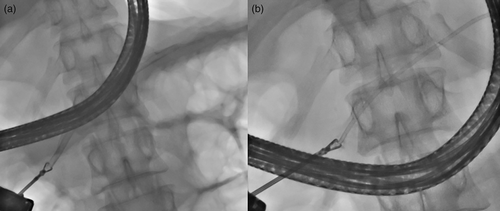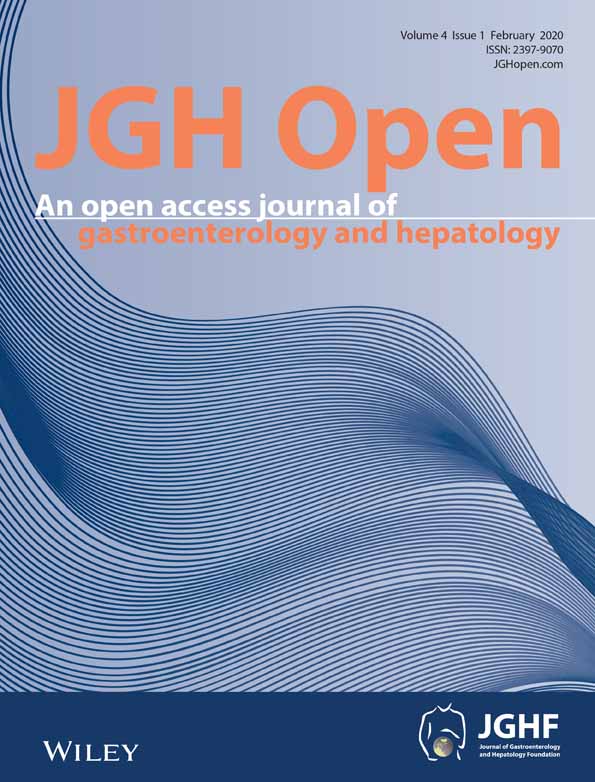Endoscopic retrieval of two proximally migrated plastic pancreatic duct stents
Abstract
Plastic stent migration is an important complication of pancreatic duct (PD) stenting, with distal (downstream) migration being more common than proximal (upstream) migration. While the distal stent migration into the duodenum is rarely of any clinical consequence, proximal stent migration can cause serious complications, including obstructive pancreatitis. The endoscopic removal of proximally migrated stents is difficult because of the small diameter of PD, the bended and sometimes tortuous course of PD, the presence of strictures, and a lack of dedicated endoscopic accessories. We report a rare case of endoscopic retrieval of two proximally migrated plastic stents from PD.
Introduction
Proximal plastic stent migration is a major concern of pancreatic duct (PD) stenting as it can lead to PD damage as well as the risk of infective complications.1 They are usually retrieved endoscopically using various techniques and accessories.1, 2 Endoscopic retrieval, although difficult, is usually successful in the majority of patients.1, 2 Usually, a single plastic stent migrates proximally, and the proximal migration of two plastic stents is very rare. We report a rare case of endoscopic retrieval of two proximally migrated plastic stents from PD.
Case report
On evaluation for chronic abdominal pain, a 36-year-old male was diagnosed with alcohol-related chronic calcific pancreatitis. Endoscopic retrograde cholangiopancreatography (ERCP) performed elsewhere demonstrated a tight stricture in the PD at mid-body level, along with upstream dilatation of the PD. After pancreatic sphincterotomy, the stricture was dilated using a Hurricane RX Biliary Balloon Dilatation Catheter (Boston Scientific, Boston, MA, USA), and a 7 Fr 12 cm stent was placed in the PD. On repeat ERCP 8 weeks later, the stent was found to have proximally migrated. Repeated attempts using snare, grasping forceps, and stone extraction balloon to retrieve the stent failed, and therefore, following further dilatation of the stricture, a 10 Fr 10 cm stent was placed alongside the inward-migrated 7 Fr stent, and the patient was referred to us. ERCP performed by us 2 months later demonstrated that the second 10 Fr stent had also migrated proximally, with both the stents lying adjacent to each other in the PD. A grasping forceps was carefully inserted into the PD, and the 10 Fr stent was first grasped at its end (Fig. 1a) and carefully removed. Thereafter, the forceps were reinserted into the PD, and the 7Fr stent was also grasped at its end and removed (Fig. 1b). The PD was recannulated, and a pancreatogram demonstrated resolution of the stricture; hence, no stents were placed. The patient remains asymptomatic after 9 months of follow up and does not require the use of analgesics.

Discussion
Plastic stent migration is an important complication of PD stenting, with distal (downstream) migration being reported in 7.5% patients and proximal (upstream) migration being reported in 5.2% patients.1, 2 While the distal stent migration into the duodenum is rarely of any clinical consequence as the stent is excreted uneventfully, proximal stent migration further into the PD results in obstructive pancreatitis.3 Proximal PD stent migration is more commonly associated with sphincter of Oddi dysfunction, straight stents, flaps on the distal portion of stent, and longer stents.1, 4, 5 These proximally migrated stents pose a serious management dilemma, with many patients requiring surgical removal of the stents. The endoscopic removal of the proximally migrated stents is more difficult because of the small diameter of PD, the bended and sometimes tortuous course of PD, the presence of PD strictures, and a lack of dedicated endoscopic accessories.4 Various endoscopic accessories and techniques, such as balloon catheters, snare, basket grasping forceps, stent retriever, stent-in-stent technique, and spy glass, aiding the removal of proximally migrated stents have been described. The overall success of the endoscopic retrieval of proximally migrated pancreatic stents has been reported to vary from 80 to 93%.1 Proximal migration of two stents, that too in the presence of ductal stricture, is very rare. Because of limited space, the endoscopic removal of two stents is more difficult than the removal of a single stent.




